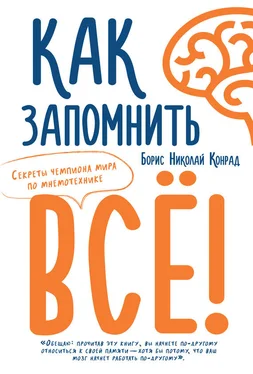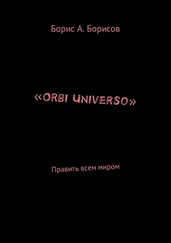1. Что такое память?
Baddeley A. (1992). Working memory. Science 255 (5044), 556–559.
Conway M. A. & Pleydell-Pearce C. W. (2000). The construction of autobiographical memories in the self-memory system. Psychological Review 107 (2), 261.
Ingalhalikar M., Smith A., Parker D., Satterthwaite T. D., Elliott M. A., Ruparel K. & Verma R. (2014). Sex differences in the structural connectome of the human brain. Proceedings of the National Academy of Sciences 111 (2), 823–828.
Miller G. A. (1956). The magical number seven, plus or minus two: Some limits on our capacity for processing information. Psychological Review 63 (2), 81.
Parker E. S., Cahill L. & McGaugh J. L. (2006). A case of unusual autobiographical remembering. Neurocase 12 (1), 35–49.
Tulving E. (1972). Episodic and semantic memory 1. In: Tulving E. & Donaldson W. (Ed.).
Organization of Memory. London: Academic, 38 02.
2. Есть ли в мозге «жесткий диск»?
Blakemore S. J. & Choudhury S. (2006). Development of the adolescent brain: Implications for executive function and social cognition. Journal of Child Psychology and Psychiatry 47 (3–4), 296–312.
Greicius M. D., Supekar K., Menon V. & Dougherty R. F. (2009). Resting-state functional connectivity reflects structural connectivity in the default mode network. Cerebral Cortex 19 (1), 72–78.
Hackman D. A. & Farah M. J . (2009). Socioeconomic status and the developing brain. Trends in Cognitive Sciences 13 (2), 65–73.
Harrison T. M., Weintraub S., Mesulam M. M. & Rogalski E. (2012). Superior memory and higher cortical volumes in unusually successful cognitive aging. Journal of the International Neuropsychological Society 18 (06), 1081–1085.
Hartshorne J. K. & Germine L. T. (2015). When does cognitive functioning peak? The asynchronous rise and fall of different cognitive abilities across the life span. Psychological Science 0956797614567339.
Hodson J. D . & Strandfeldt F. M. (1988). U. S. Patent № D297, 234. Washington, DC: U. S. Patent and Trademark Office.
Konrad B. N. (2014). Characteristics and neuronal correlates of superior memory performance. Diss., Ludwig-Maximilians-Universität München.
Kramer A. F., Erickson K. I. & Colcombe S. J. (2006). Exercise, cognition, and the aging brain. Journal of Applied Physiology 101 (4), 1237–1242.
Lafuente M. J., Grifol R., Segarra J., Soriano J., Gorba M. A. & Montesinos A. (1997). Effects of the Firstart method of prenatal stimulation on psychomotor development: The first six months. Pre- and Peri-Natal Psychology Journal 11 (3), 151.
Lashley K. S. (1950). In search of the engram. Society of Experimental Biology Symposium IV, 454–482.
Markram H., Muller E., Ramaswamy S., Reimann M. W., Abdellah M., Sanchez C. A. … & Kahou G. A. A. (2015). Reconstruction and simulation of neocortical microcircuitry. Cell 163 (2), 456–492.
Montague P. R., Hyman S. E. & Cohen J. D. (2004). Computational roles for dopamine in behavioural control. Nature 431 (7010), 760–767.
Nunes A. & Kramer A. F. (2009). Experience-based mitigation of age-related performance declines: Evidence from air traffic control. Journal of Experimental Psychology: Applied 15 (1), 12.
O’Connor C., Rees G . & Joffe H. (2012). Neuroscience in the public sphere. Neuron 74 (2), 220–226.
Paus T., Zijdenbos A., Worsley K., Collins D. L., Blumenthal J., Giedd J. N. … Evans A. C. (1999). Structural maturation of neural pathways in children and adolescents: In vivo study. Science 283 (5409), 1908–1911.
Penfield W. & Jasper H. (1954). Epilepsy and the Functional Anatomy of the Human Brain. Oxford: Little, Brown & Co.
Pujol J., Vendrell P., Junqué C., Martí – Vilalta J. L . & Capdevila A. (1993). When does human brain development end? Evidence of corpus callosum growth up to adulthood. Annals of Neurology 34 (1), 71–75.
Quiroga R. Q., Reddy L., Kreiman G., Koch C. & Fried I. (2005). Invariant visual representation by single neurons in the human brain. Nature 435 (7045), 1102–1107.
Rakic P. (2006). No more cortical neurons for you. Science 313 (5789), 928 f.
Raichle M. E., MacLeod A. M., Snyder A. Z., Powers W. J., Gusnard D. A. & Shulman G. L. (2001). A default mode of brain function. Proceedings of the National Academy of Sciences 98 (2), 676–682.
Ramon M., Miellet S., Dzieciol A. M., Konrad B. N., Dresler M. & Caldara R. (2016). Super-memorizers are not super-recognizers. PLOS One, 11 (3).
Sherwood C. C., Gordon A. D., Allen J. S., Phillips K. A., Erwin J. M., Hof P. R. & Hopkins W. D. (2011). Aging of the cerebral cortex differs between humans and chimpanzees. Proceedings of the National Academy of Sciences 108 (32), 13029–13034.
Silver D., Huang A., Maddison C. J., Guez A., Sifre L., Van Den Driessche G. … & Dieleman S. (2016). Mastering the game of Go with deep neural networks and tree search. Nature 529 (7587), 484–489.
Snowdon D. A., Greiner L. H., Mortimer J. A., Riley K. P., Greiner P. A. & Markesbery W. R. (1997). Brain infarction and the clinical expression of Alzheimer disease: The Nun Study. Jama 277 (10), 813–817.
Stern Y. (2002). What is cognitive reserve? Theory and research application of the reserve concept. Journal of the International Neuropsychological Society 8 (03), 448–460.
Van Essen D. C., Smith S. M., Barch D. M., Behrens T. E., Yacoub E., Ugurbil K. & WU-Minn HCP Consortium (2013). The WU-Minn human connectome project: An overview. Neuroimage 80, 62–79.
Whalley L. J. & Deary I. J. (2001). Longitudinal cohort study of childhood IQ and survival up to age 76. British Medical Journal 322 (7290), 819.
Williams J. W., Plassman B. L., Burke J., Holsinger T. & Benjamin S. (2010). Preventing Alzheimer’s disease and cognitive decline. Evidence Report/Technology Assessment № 193. Rockville MD: Agency for Healthcare Research and Quality.
3. Обучение, запоминание и забывание
Barz H. & Liebenwein S. (2012). Bildungserfahrungen an Waldorfschulen: Empirische Studie zu Schulqualität und Lernerfahrungen. Wiesbaden: Springer.
Behne K. E. (1999). Zu einer Theorie der Wirkungslosigkeit von (Hintergrund-)Musik. Jahrbuch der Deutschen Gesellschaft für Musikpsychologie 14, 7–23.
Blank H., Fischer V. & Erdfelder E. (2003). Hindsight bias in political elections. Memory 11 (4–5), 491–504.
Brown R. & McNeill D. (1966). The «tip of the tongue» phenomenon. Journal of Verbal Learning and Verbal Behavior 5 (4), 325–337.
Deci E. L., Koestner R. & Ryan R. M. (1999). A meta-analytic review of experiments examining the effects of extrinsic rewards on intrinsic motivation. Psychological Bulletin 125 (6), 627.
Ebbinghaus H. (1885) Über das Gedächtnis. Untersuchungen zur experimentellen Psychologie. Leipzig: Duncker & Humblot.
Ericsson K. A. & Charness N. (1994). Expert performance: Its structure and acquisition. American Psychologist 49 (8), 725.
Ericsson K. A. & Kintsch W. (1995). Long-term working memory. Psychological Review 102 (2), 211.
Читать дальше
Конец ознакомительного отрывка
Купить книгу











